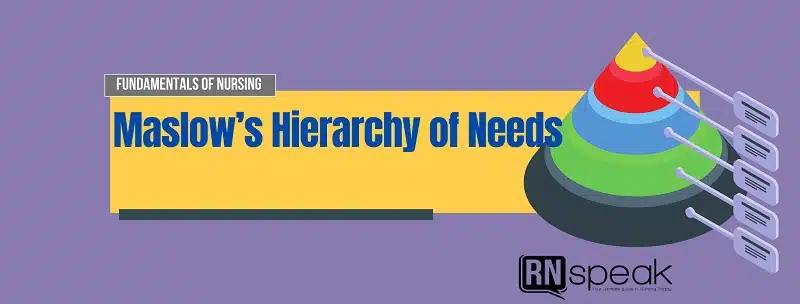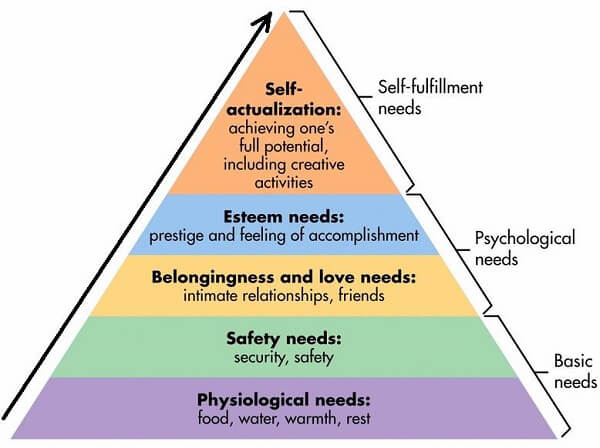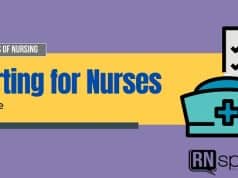Nurses operate daily, keeping efficiency intact and safety as the highest priority at all costs. With the help of Maslow’s hierarchy of needs, they alleviate their clients’ optimum health through effective Management of interventions.
Learn how Maslow presented all of these needs in a straightforward way to understand them through a pyramid.
Maslow’s Hierarchy of Needs
- Founded in 1943 by an American psychologist, Abraham Maslow, who owned Russian origins
- It serves as the ultimate basis for medical teams to set their patient care, especially in prioritization.
- It came from Maslow’s curiosity about why men don’t aspire for something that matches its complex nature considering his spiritual self
- Was divided into D-needs and B-needs.
- A conceptualized human needs model is represented through a pyramid in ascending order starting with physiological needs as the base, safety, and security at the second level, love and belongingness on the third, self-esteem on the fourth, and the last sits atop the summit, self-actualization.
The Hierarchy
5 Levels of Maslow’s Hierarchy of Needs
1. Physiological or Basic Needs
- Needs at this level root from the body’s calling to growth. Hence, an adaptation of the word ‘physiological.’
- Attending to these needs assures one’s survival.
- Deteriorates one’s physical performance and thought process if not met
- Needs immediate action such as food, oxygen, air, water, shelter, and even sex, (with that basic instinct to breed)
- Nurses take this as the first that needs to be attended to above all. Understanding the nature of these needs helps the nursing care plan to prioritize efficiently.
- Examples of this would be freeing the nasogastric tube (NGT) of any obstruction to inflow and outflow, timely appropriate intake and output (I&O), and checking placements of IV, assuring overall bedside care.
2. Safety and Security Needs
- The need for protection and stability falls under this level.
-
- Example: shelter, a peaceful community, an environment free from toxic and hazardous chemicals, clothing, a job, means of transportation
-
- It becomes an essential need if a person’s survival is at stake.
- Its emergence pertains to the environment the person is moving into or moving into; Take the scenario of a patient who has paralysis. There’s the risk of embolism, bedsore, and falls – all of which account for safety and security needs. But if pulmonary embolism happens and the patient goes into cardiac arrest, physiologic needs arise since it puts a threat to survival.
- Man’s ability to perform or function deteriorates if these needs are not met. For example, if the bedside railing is not secure, the patient may feel stressed out, affecting his ability to have a sound sleep.
- Physiological needs may also be compromised if a person doesn’t feel safe and secure because it makes him chronically stressed. Stress manifests an increase in blood pressure and pulse rate.
- If blood pressure reaching 180/120 is measured and is left untreated, life expectancy is decreased, and the chance for PVD or pulmonary vascular disease increases. This means an 80% chance of dying sooner than expected to make the average rate for survival to just 10 months.
- Not immediate, but if not met, it may affect the fulfillment of physiologic needs.
-
- Example: access to clean air – If you are admitted to the hospital, and you get a viral infection within the premises, this is a perceived deficiency affecting safety and security. But as the air gets contaminated, the physiological need for it becomes deficient and overlays the need for security and safety needs.
-
- The need to have access to medical care, emergency personnel, police, and a fire station all fall under here too
- In terms of bedside care, safety, and security needs include freedom from nosocomial or hospital-acquired infection, absence of faulty medical equipment, malpractice, and inappropriate diagnostic procedures.
- Some hospital policies and operational guidelines are based on looking after a client’s safety and security needs, such as preparing an occupied bed, moving patients, and access to a crash cart.
3. Love and Belongingness
- It seems to appear and get acknowledged when the first two levels are satisfied.
- How people regard their social life, communities, and connections fall under love and belongingness
- This is the satisfaction that comes from knowing you are not alone and that you have somebody to relate to.
- The need for ‘belongingness,’ being an inherent trait amongst human beings, poses serious psychological consequences and affectation when not met.
- It gives a deeper desire of wanting to be part of something bigger than themselves.
- Triggered by the realization that a life’s journey becomes worthless when they don’t have somebody to share it with, nor does it seem worth attaining if they end up on their own.
-
- Examples: getting married, being part of an association, getting baptized to be in a certain religious group.
-
In the clinical setting, having a support group and getting hold of the same people who had the same experiences, such as AA or Alcoholics Anonymous and Drug Rehabilitation Centers, are means to satisfy these needs.
- Many treatments include alleviating quality of life as part of interventions given to patients. As Florence Nightingale practiced during her own time, the backbone for bedside care is the consideration of a human need for care and empathy.
- Also, much miraculous healing and recovery may be attributed to the fulfillment of such needs.
- Where concepts of touch therapy, co-bedding amongst twins, and breastfeeding were based upon
- Reproductive health and family planning also support social and intimacy needs.
4. Esteem Needs
- Needs that pertain to the natural desire to be accepted and valued
- Refers to the need to be respected to gain self-confidence
- In Nursing, esteem needs include those that concern independence, dexterity, and mental control. Considering those reaching senescence that may be compromised of independence remarkably. Not to mention debilitated patients, patients who are in post-op, amputated patients, and those who had negative vaccine results. Some had come out injured from their workplace, which could limit their dexterity. Carpal Tunnel Syndrome is one. And finally, there’s great anxiety and stress that may result from post-traumatic stress disorder (PTSD), for example, which could disrupt self-esteem and sense of functionality.
- A pursuit that can be achieved in two ways:
1. Esteem needs to be met on their own
Example: gaining control, paying bills, performing activities of daily living independently, and knowing how to read and write.
2. Esteem needs to be met by others
Examples: Reputation, promotion, being seen as an inspiration, and becoming an influence
These needs and the first three levels complete the Deficiency Needs.
5. Self – Actualization
- Reaching and realizing one’s full potential in terms of talent and skills.
- The more it gets fulfilled, the more the need for it grows.
- Usually observed and gauged in tertiary intervention when applied to bedside care. Nurses feed the will of patients in recovery by grading their performances.
- For example, surgical doctors who were able to operate again after successful occupational therapy, cancer-free after chemotherapy, and senile people whose independence is still intact.
Note: This is the only set of needs that belong to Being Needs, also known as the B-Needs.
D-needs vs B-needs
The grand difference can be derived from their names. Deficiency Needs (D-Needs) that fall from Level 1 to 4 arise when a deficiency is felt. The need for protection addresses the lack of resources. And the more they get satisfied, the lesser the demand, the lesser they become needs.
Example: Hunger results from food deficiency as much as thirst results from water deficiency. When you are tired, it means you lack rest.
Compared to the Being Needs (B-Needs), whose main focus is self-actualization, these needs pertain to a person’s drive to reach something bigger than oneself. It resides on top of the pyramid’s summit representing the highest achievement a person can be defined with. These needs are all about becoming the most one can be and reaching the utmost potential that one has. And this includes the creative aspect. What’s remarkable about it is how it opposes the D-Needs.
While D-Needs emerge from a lack of being needs, they arise from having it satisfied in the first place. To put it in perspective, the more you attend to the B-Needs, the more the demand for it grows. Owning a patent, earning a Ph.D., and even as simple as writing and having a book published are forms of Being Needs getting satisfied. Being Needs is also known as Growth Needs.
Needs vs Wants
Wants – things a person long to have; often what you wish for
Example: Car, a diamond ring, a mansion, a million dollars
Needs – are necessary wants; usually prioritized according to a person’s survival
instinct; needs to be prioritized
Example: Water, food, sleep, education, family, legacy
What is the essence of a pyramid in the hierarchy’s arrangement?
- The pyramid was the chosen model for this theory by Maslow because of his desire to create an ideal structure for man to follow in pursuing his purpose. It is brilliant in many ways, where it serves as a reminder to all that prioritization is key.
- Universally, pyramids have a strong base supporting everything that sits atop them, providing a sturdy hold on the ground. Looking at how Maslow developed his hierarchy of needs, it does serve as a cornerstone for many behavioral studies.
- Non-negotiable needs are on the base since it provides the ultimate assurance for fulfilling the other needs once attended to faithfully.
- In this regard, a nursing care plan is guided into formulating radical interventions following a logical sequence of attending to needs through Maslow’s model. While considering a patient’s plan of treatments as a whole, pieces of how to reach such an overall wellness goal were strongly mandated in full awareness of how each contributes to the implementation.
The shapes and directions the pyramid represents.
- How each stage of needs is presented in a pyramid captured many because of the intricate truth it represents. While our spirit’s aspirations cannot be fulfilled by our spirit alone, they should remain balanced considering the basic needs. Hence, its allocation on the first level serves as a sturdy base.
- The base lends support, and the summit represents the upward direction and definition in parallel with the motives of self-actualization.
- Subjectively, all humans possess a different learning curve. How we project our interpretation of a pyramid reflects how we prioritize. Ideally, following the pyramid is the way, but human personalities are always complex. But its imperfection creates waves of learning opportunities.
- And when each person is regarded individually, their esteem needs become sturdy. There are tremendous results that root from this, especially amongst patients who have stayed in the hospital because of chronic conditions.
How is Maslow’s Hierarchy of Needs Helpful?
1. It serves as a basis for all business models in which success is always one of the strongest pursuits. What many do not know was that Maslow, in the very last days of his long life, longed for more businesses to consider offering products that lead people into fulfilling self-actualization rather than paying attention only to the basic ones.
2. It provides an ideal life structure for many people who seek direction on how to fulfill their purpose.
3. It is the basis of medical and nursing applications acknowledging both physiological and psychological needs.
4. Maslow’s Hierarchy of Needs served as the basis for nursing care plans. The decision-making and prioritization processes for critical Management and bedside care follow the hierarchy faithfully. Though in consideration of the other prioritization models such as ABC (airway, breathing, circulation) and other psychological theories, Abraham Maslow’s seem to be the most applicable until today.
Application of Maslow’s Hierarchy of Needs to Modern Nursing
Maslow’s Hierarchy of needs Nursing
A nurse had been regarded as more than just a giver of health care because, besides her knowledge in medicine, she has high regard for benevolence in providing care for her patients to the best of her ability. And one of every nurse’s important tasks is to look after their welfare, attending to both physiological and psychological needs.
As Maslow conceptualized this hierarchy of needs, it had been in every nurse’s toolbox to be regarded as the proper guide in conducting a physical assessment, attending to emergency care, and planning nursing interventions while regarding prioritization and optimum health.
Nurses consider this in pain management as well, in which only the patient’s subjective interpretation is the only basis for how extensive the treatment should be adjusted. Considering the hierarchy of needs by Maslow as the backbone of patient care priorities, Management had improved remarkably. It is the only guide that addresses self-actualization, which may be attained at different levels.
It could be as simple as autonomy, independence, and an increased range of motion after a great trauma or surgery. All of which alleviates a person’s depressive state into embracing drive, a positive mindset, and willingness. So, this way, both physiological and psychological aspect’s needs are met.
In the same way, nurses are helped themselves as they give patient care. Often, nurses face a lack of workforce they had to attend to more than 8 patients per shift. But as Maslow’s Hierarchy of Needs gives them enlightenment in prioritization, nurses plan better, allowing them to manage their time for their work while imparting quality care.
They realize the consequence of not eating on time, not having adequate rest, and how exhaustion could affect a person’s ability to do tasks. So, they make sure they find time to get some relaxation and socialization when they can without feeling guilty, nervous, or exhausted.
Maslow had been aiding all nurses in doing their jobs efficiently. It provides overall clarity in each intervention they perform and each patient care they provide.
References
- A Theory of Human Motivation – Psychological Review, 50(4), 370-96 paper proposed by Maslow, A. H. (1943)
2. Motivation and Personality: 3RD Edition – book by Maslow A.H. revised by Roger Fraser, James Fadiman, Cynthia McReynolds, and Ruth Cox (1997)
3. Maslow on Management – book by Abraham Maslow (1965)








![FDAR Charting for Nurses [5 Tips for Effective FDAR Charting & Common Mistakes to Avoid] Fdar charting](https://rnspeak.com/wp-content/uploads/2023/06/Fdar-charting-238x178.jpg)





Thank you for the concise articles! Very informative.
Sam Tylo RN